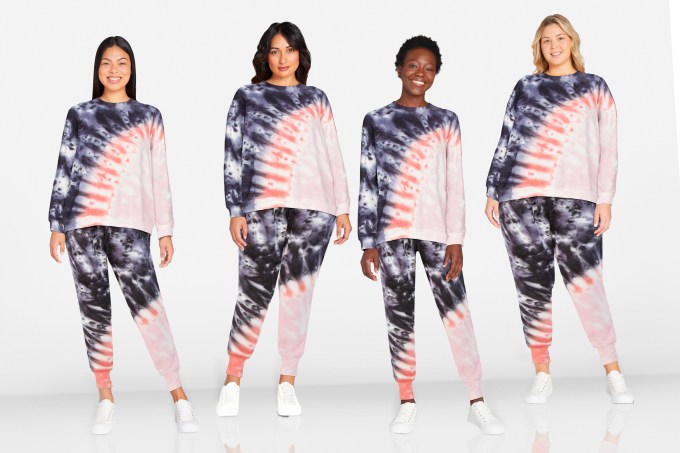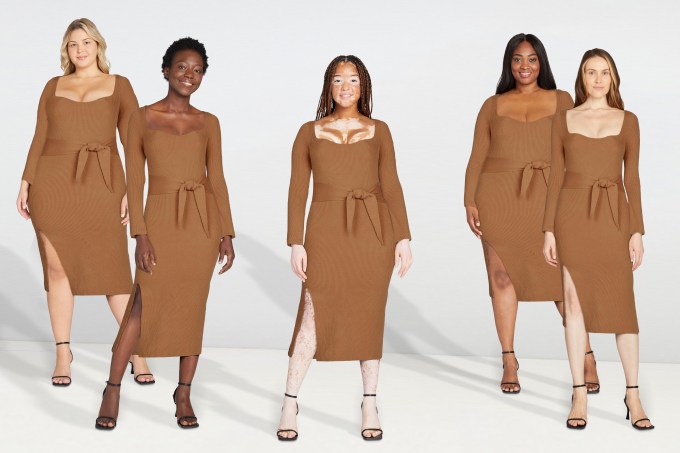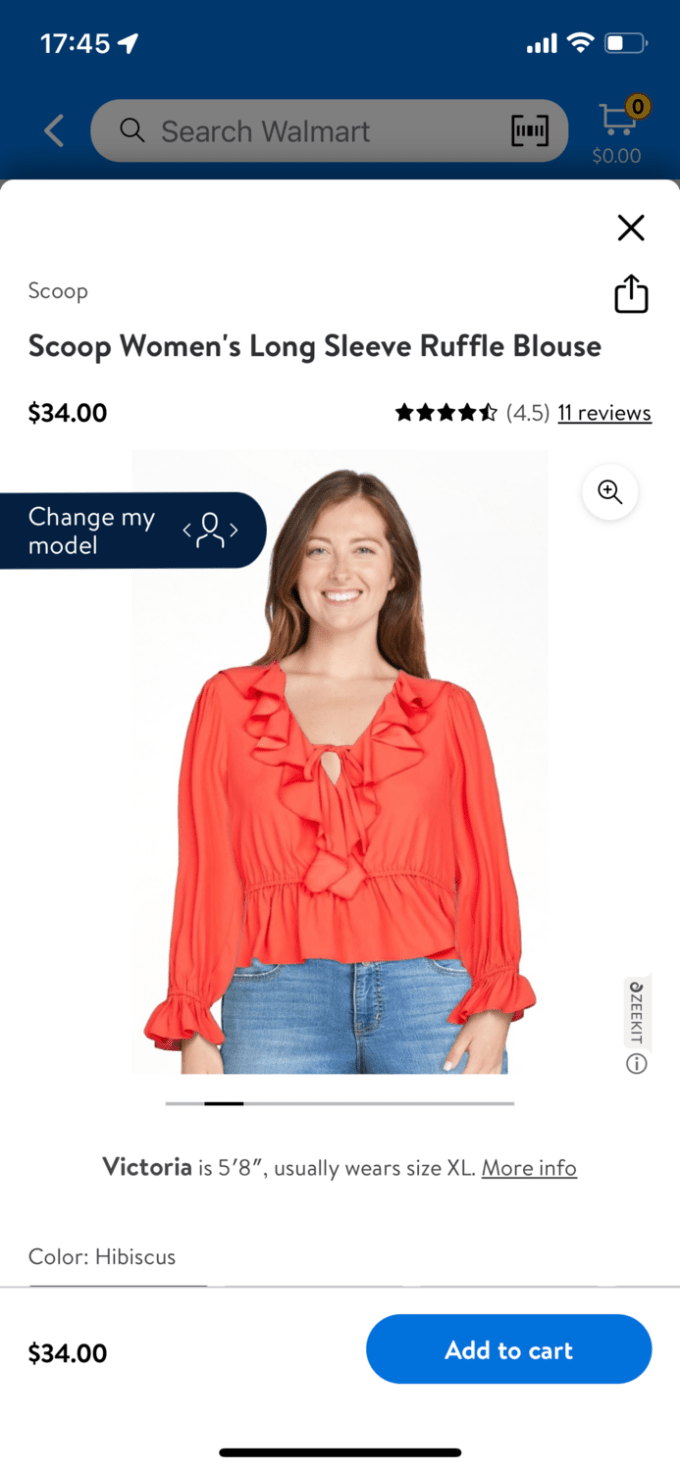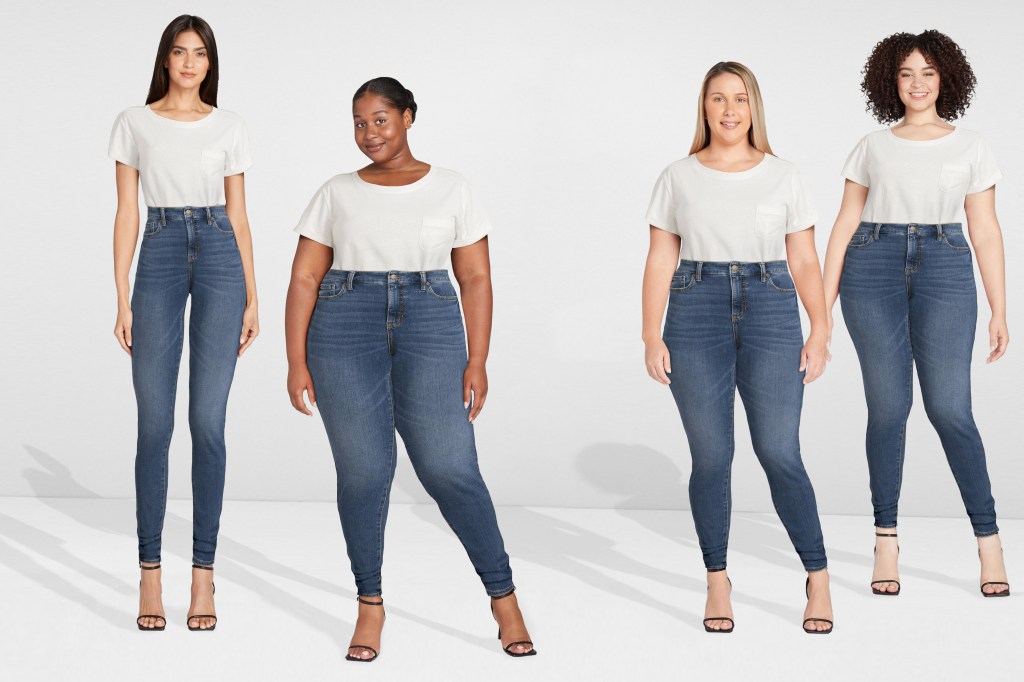Last May, Walmart announced its acquisition of the virtual clothing try-on startup Zeekit, which leveraged a combination of real-time image processing, computer vision, deep learning and other AI technologies to show shoppers how they would look in an item by way of a simulation that takes into account body dimensions, fit, size and even the fabric of the garment itself. Today, Walmart says it’s bringing that technology to Walmart.com and its Walmart mobile app.
The retailer is introducing the computer vision neural network-powered “Choose My Model” try-on feature, now in beta, which will now allow Walmart customers to select a model that better matches their own appearance and body type. At launch, online shoppers will be able to choose from among 50 different models to find one who best reflects their own skin tone, height and body shape so they can get a better idea of how clothing would look on them.
These virtual models currently range in height between 5’2″ and 6’0″ and in sizes XS through XXXL. Walmart notes it will continue to expand its model selection over time, with plans to launch nearly 70 additional models in the weeks ahead to offer more variety in terms of size, skin tone and even hair color.
The new feature is powered by Walmart Global Tech’s neural networks, which analyze catalog images of garments to create a dressed image using computer vision algorithms across a diverse set of Walmart model images, the company explains in its announcement about the product’s launch.
The use of neural networks helps to determine the different variations available in a single product, which doesn’t just include its size, but could also include other factors, like available color options or even sleeve length. The new system is able to capture all these variations when displaying the options, the retailer says.

The “Choose My Model” feature, which focuses on women’s fashion, will work with thousands of items across Walmart’s own portfolio of exclusive and private brands, including Free Assembly, Scoop, Sofia Jeans by Sofia Vergara, ELOQUII Elements, Time and Tru, Athletic Works, Terra & Sky, No Boundaries, Avia and The Pioneer Woman. It’s also in the process of adding national brands, beginning with Levi’s, Hanes, Just My Size, Secret Treasures and Como Blu.
Over time, it will expand to include more national brands, including those both on Walmart.com and the Walmart Marketplace. The company notes it’s easier to enable the technology across its own brands because it owns the inventory and catalog of items.
Ahead of its acquisition, Zeekit had been working with a number of retailers, including Walmart, as well as other well-known brands like Tommy Hilfiger and Adidas. This existing work with Walmart helped speed the time it took to bring the technology to the public through the Walmart website and mobile app integration.

When shopping on Walmart.com or in the Walmart app, customers will now see prompts that say “Change my model” to select a model on the clothing item’s page if the new virtual try-on technology is available for that product. These prompts will appear across Walmart.com as well as on the iOS and Android mobile apps.
According to Desi Gosby, Walmart’s VP Emerging Tech, the model a customer selects will continue to be shown with apparel items that are Zeekit-enabled for future shopping visits. However, the customer will need to choose their preferred model across each device — that is, if the customer selects a model on the web, it won’t carry over to iOS.
At the time of the acquisition, Walmart had mentioned a social sharing feature that would let friends give each other feedback on virtual outfits, but that feature is not live. But the retailer says it could be a future capability for virtual try-on.
During tests, Walmart said it received positive customer feedback about the experience, which it hopes will make online clothes shopping feel more like in-person shopping.
“One of the most frustrating aspects of shopping for clothes online is understanding how an item will actually look on you. With Zeekit, our goal is to deliver an inclusive, immersive and personalized digital experience that will better replicate physical shopping,” said Denise Incandela, Walmart U.S. EVP of Apparel and Private Brands.
Of course, helping customers choose products that look right on them isn’t just about being responsive to customer needs or encouraging a purchase — it’s about helping to cut down on the number of returns of clothes that don’t work when tried on at home. Walmart has tried to address the customer hassle portion of the problem by offering the option to return or exchange online purchases to its retail stores. But the ideal scenario would be a reduction in returns altogether.

Better try-on tech could also help Walmart in its battle with Amazon, which jumped into the lead last year as the number one apparel retailer in the U.S., ahead of Walmart — a spot it was able to claim, in part, due to the COVID pandemic and the resulting increase in online shopping. Walmart, however, had been impacted by “weaker demand” for apparel in the early months of 2021, but recovered toward the end of the year thanks to holiday sales. (It did not break out its apparel sales in Q4, though.)
The idea to offer virtual try-on is something many startups have experimented with over the past decade and beyond, as well, including Fitle, Metail, Virtusize, Fits.me and several others. These sorts of companies have also been the subject of acquisitions, like eBay’s 2014 deal for PhiSix for 3D try-on tech, for instance. More recently, a startup called Revery.ai was raising funding for its computer vision-powered tech that lets customers pick their model to virtually try on clothes.
However, Walmart’s adoption of a virtual try-on feature could push the broader e-commerce industry to integrate similar technology inside their own websites and apps in the future.































Comment